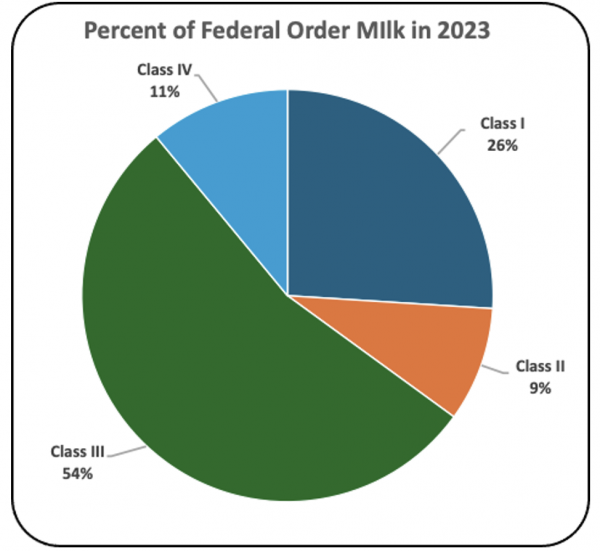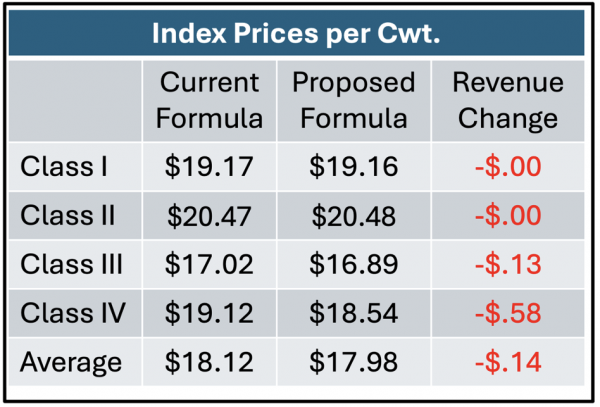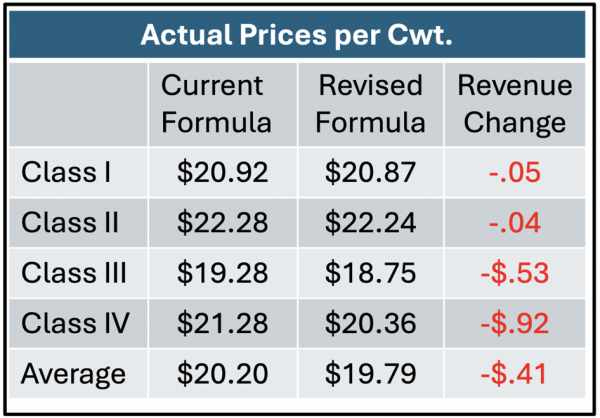The USDA has approved changes to the formulas for Class I, II, III, and IV producer milk. They are now being reviewed by the Federal Orders. If approved, the new formulas will be used for future calculations of the value of producer milk. If not approved by the Federal Order, the Order will be disbanded.
The three prior posts, listed below covered the impact on Class III milk, the largest share. Class IV milk, and Class I milk.
Prior to 2019, Class I skim milk was priced by the “higher of” Class III skim or Class IV skim. Since 2019, the Class I skim has been priced based on the “average of“ Class III skim and Class IV skim plus $.74. The USDA changes will return the pricing formula to the “higher of“ calculation.
USDA Rule Change to Federal Order Pricing – Part I – Class III milk – Milk for cheese
USDA Rule Change to Federal Order Pricing – Part II – Class IV milk – Milk for butter
USDA Rule Change to Federal Order Pricing – Part III – Class I milk – Milk for drinking
This post summarizes the changes for all Classes of Milk.
Below is Chart I which compares the percent for producer milk by Class. The use of Federal Order milk for cheese is by far the largest category with 54% of the total volume. Class I is next with 26% and Classes II and IV are smaller with 9% and 11%.

Some publications have stated that the USDA changes will financially benefit producers. That is not true. Producers in the Federal Orders will be paid less as the new formulas are implemented. The changes now approved by the USDA are the most sweeping changes ever approved. Typically, only “make allowances” are changed. The current changes cover much more.
The data used for the calculations in this post is based on 2023 volumes, prices, and component levels. The two tables below cover both the changes to the index formulas which use standardized levels of components (TABLE I), and the actual revenue changes that will occur for producer payments (TABLE II).
INDEX PRICES
No producer is paid by the index prices published monthly. The index prices use a consistent level of components and standardized formulas to track the impact on producer milk as wholesale dairy product prices fluctuate.
The changes in index prices (TABLE I below) show almost no change in revenue for Class I and Class II milk. Butterfat becomes worth less with a higher “make allowance” and skim milk increases in value by using the “higher of” Class III or Class IV instead of the current averaging method.
Class III milk has a small negative impact of just -$.13 per cwt. as butterfat and “other solids” value is less with the increased “make allowances.” However, the Class III formula will increase and offset most of the losses by using a skim protein level of 3.3% as opposed to 3.1% in the current formulas. This does make comparisons to historical index prices incomparable.
No changes in butterfat component levels are made in the USDA changes, and it will remain at 3.5% even though current butterfat levels are above 4%.
Class IV milk for butter will be worth significantly less by $-.58 per cwt. Butterfat will be lower due to the higher “make allowances,” which impact all Classes of milk equally. The impact of the “milk allowance” of nonfat dry milk has a very significant increase of 43%, increasing from $.1678 per pound to $.2393 per pound which lowers the producer revenue for skim milk in Class IV. The changing pricing technique used for Class III milk protein is used in Class IV to increase nonfat solids to 9.3% from 9% of skim milk in the index formulas. The negative impact of the “make allowance” far outweighs of the impact of increasing the level of nonfat solids. As mentioned above, the change in the level of “nonfat solids” makes comparisons to historical data incompatible.

ACTUAL REVENUE PRICES
Chart III covers the actual impact of the changes on producer revenue. The difference is in the actual component levels which are measured with every load of milk. All classes are now showing lower prices. The weighted average represents the statistical uniform price used for producer payments.





